How NATO is committing Cyber Warfare against the global masses
by Dan Fournier, published Wednesday, Feb. 15, 11:32 EST on fournier.substack.com
Depiction of nefarious cyber warfare. Image source.
In a previous article – which was republished in ActivistPost, and The Burning Platform – readers were introduced on how the North Atlantic Treaty Organization, better known as NATO, have created a fifth operational domain (the first four being air, land, sea, space) called cyber which they use with great success to propagandise and brainwash the masses around the globe, particularly on social media, as an instrument to gain support for their war follies.
This article will provide a more detailed assessment of this important form of covert warfare, as it is, stealthily yet effectively, being perpetrated on ordinary people without them even knowing they are its targeted subjects.
What is Cyber Warfare?
Though Cyber Warfare is often described as actions by a nation-states or international organizations to attack and attempt to damage another nation's computers or information networks, what is seldom left out is how it is used to great effect on social media and is aimed towards ordinary citizens.
According to Imperva, there are 7 types of Cyber Warfare attacks:
The one of concern here is ‘Propaganda Attacks’ which they define as follows [emphasis added].
“Attempts to control the minds and thoughts of people living in or fighting for a target country. Propaganda can be used to expose embarrassing truths, spread lies to make people lose trust in their country, or side with their enemies.”
Looking at this definition, it becomes apparent that propaganda is a kind of mind control. Other definitions for propaganda include:
“Propaganda is information that is not impartial and used primarily to influence an audience and further an agenda, often by presenting facts selectively (perhaps lying by omission).”
and
“Information or ideas that are spread by an organized group or government to influence people’s opinions, especially by not giving all the facts or by secretly emphasizing only one way of looking at the facts. (Cambridge Dictionary)”
The above definition makes reference to ideas spread by organisations or even the government. In fact, the word government is quite telling in itself, though most people don’t even realise the etymological significance of the word itself.
The definition continues, “to influence people’s opinions, especially by not giving all the facts or by secretly emphasizing only one way of looking at the facts.”
Both of these points have been omnipresent during the Covid-19 Pandemic. First, it is no secret that fear was used with great success by governments, health authorities and other group to ensure compliance of wearing of masks, lockdowns, and being subject to an experimental medical procedure, i.e., the Covid-19 vaccines. Furthermore, many important facts about the SARS-CoV-2 virus and related information were censored and omitted (not reported on) by the corporate media.
In the case of the Covid-19 Pandemic, the topic at hand was the management of health crisis itself. But here the topic at hand is war.
Similar to how propaganda and other mind control techniques, such as Mass Formation Psychosis, were used during the Covid-19 Pandemic, similar ones are now being employed to get people from all around the world to sympathise with and side with the Ukraine in the ongoing Russia-Ukraine War, even though this belligerent has a systemic corruption problem and a dreadful human rights record.
NATO, the United States, Canada, the United Kingdom, and other allies have been unswerving in their efforts to escalate this war for various reasons such as increasing the profits of the military-industrial complex, as well as to further antagonise Russia. They are not only providing massive amounts of funds to the corrupt Ukrainian regime, but are also dangerously increasing the funneling of military weapons to the conflict zone, carelessly setting the stage for further bloodshed and destruction – on both sides, not to mention the possibility of fomenting a nuclear exchange.
Fifth Generation Warfare
Getting back to NATO and Cyber Warfare, the sophistication upon which this form of military operation is used in this Information Age must be scrutinised to better understand its intentions and net effects.
Before delving into NATO’s specific cyber warfare treatise, it is worthwhile to first consult The Epoch Times John Mac Ghlionn’s article titled The WEF Wants to Hack Your Brain so as to have a bigger picture view of what is really happening.
“Hacking the brain” has been an ongoing theme at the World Economic Forum (WEF) which must be taken seriously. The article makes reference to how NATO chaired a forum exploring the “weaponization of brain sciences” and “exploiting the vulnerabilities of the human brain.”
Project Censored – #18 The Human Mind as “New Domain of War”: NATO Plans for Cognitive Warfare, November 26, 2022.
The Project Censored article interestingly noted Canada’s role in the project [with emphasis and links added]:
“On October 5, 2021, the NATO Association of Canada (NAOC) sponsored a forum on what panelists described as the “weaponization of brain sciences” to exploit “vulnerabilities of the human brain” in service of more sophisticated forms of social engineering and control. As Ben Norton reported for the Grayzone, “with its development of cognitive warfare strategies,” NATO has added a new, sixth level to the five operational domains—air, land, sea, space, and cyber—that the alliances’ member nations have previously sought to control.”
“The NAOC panel discussion was part of NATO’s Fall 2021 Innovation Challenge, hosted by Canada, which sought to enlist the expertise of private entrepreneurs and academic researchers “to help develop new tactics and technologies for the military alliance,” Ben Norton reported. (The NAOC, he noted, is technically a nongovernmental organization, but “its mission is to promote NATO.”)”
Screenshot of Canada’s National Defence’s Fall 2021 NATO Innovation Challenge. Notice the crest on the right-hand site which is that of The Canadian Special Operations Forces Command (CANSOFCOM).
From a related article we also have the following notable passage which describes the manner in which NATO’s Fall 2021 Innovation Challenge, hosted by Canada, seeks to operate:
““Cognitive warfare seeks to change not only what people think, but also how they act,” the Canadian government wrote in its official statement on the challenge. “Attacks against the cognitive domain involve the integration of cyber, disinformation/misinformation, psychological, and social-engineering capabilities.””
“Ottawa’s press release continued: “Cognitive warfare positions the mind as a battle space and contested domain. Its objective is to sow dissonance, instigate conflicting narratives, polarize opinion, and radicalize groups. Cognitive warfare can motivate people to act in ways that can disrupt or fragment an otherwise cohesive society.””
Put simply, the tactics of creating dis/misinformation, dissonance, conflicting narratives, promoting the polarization of opinions, and radicalising groups are integral to their cognitive warfare’s modus operandi.
Returning to the Project Censored piece:
“One panelist, Marie-Pierre Raymond, who represented the Canadian Armed Forces’ Innovation for Defense Excellence and Security Program, stated that “the rapid evolution of neurosciences as a tool of war” hinges on developments in artificial intelligence, big data, and social media.”
Panelists of the NAOC, part of NATO’s Fall 2021 Innovation Challenge, hosted by Canada. Image source: The Grayzone – Behind NATO’s ‘cognitive warfare’: ‘Battle for your brain’ waged by Western militaries.
“As Norton noted, panelists representing NATO interests sought to ensure corporations that their shareholders would “continue to profit” from NATO’s “imperial endeavors.””
That passage above must be re-emphasised, for it suggest that the panelists involved represent NATO interests seeking to ensure that corporations would “continue to profit” from NATO’s “imperial endeavors.”
It is quite telling, for it appears to suggest that a large objective of this exercise is geared towards ensuring financial profits of corporations, presumable of the military/security-industrial complex in the pursuit of its imperialism, i.e., the preservation and continued expansion of the Anglo-American Empire.
Continuing with the Project Censored article,
“The panel’s focus was guided by a 2020 NATO-sponsored study titled “Cognitive Warfare” and authored by François du Cluzel [a former French military officer], who manages the NATO Innovation Hub (archived here) and was one of the event’s featured speakers. According to du Cluzel’s report, the objectives of cognitive warfare are “to make everyone a weapon” and “to harm societies,” rather than simply targeting an enemy’s armed forces.”
Moreover, as this passage states, apart from the financial interests, some of its main objectives are to “make everyone a weapon” and “harm societies.”
Looking at the amount of hatred and division online and in social media outlets, such as Twitter, in particular, one can easily surmise that this operation is already in full swing.
“Furthermore, cognitive warfare is “potentially endless since there can be no peace treaty or surrender for this type of conflict.” For these reasons, “the human mind is now being considered as a new domain of war.””
In other words, this is a form of information warfare, or, more precisely, fifth generation warfare.
Addendum (2023-03-10): See also Dr. Robert Malone’s presentation on fifth generation warfare.
Ben Norton’s Behind NATO’s ‘cognitive warfare’: ‘Battle for your brain’ waged by Western militaries additional clarity on the matter.
“Now, NATO is spinning out an entirely new kind of combat it has branded cognitive warfare. Described as the “weaponization of brain sciences,” the new method involves “hacking the individual” by exploiting “the vulnerabilities of the human brain” in order to implement more sophisticated “social engineering.””
Social engineering is key here.
“A 2020 NATO-sponsored study of this new form of warfare clearly explained, “While actions taken in the five domains are executed in order to have an effect on the human domain, cognitive warfare’s objective is to make everyone a weapon.”
“The brain will be the battlefield of the 21st century,” the report stressed.
“Humans are the contested domain,” and “future conflicts will likely occur amongst the people digitally first and physically thereafter in proximity to hubs of political and economic power.”
The 2020 NATO-sponsored study on cognitive warfare. Source: Cognitive Warfare Project – Reference Documents – Cognitive Warfare.
“Humans are the contested domain,” in other words, in this type of warfare it is ordinary citizens who are targeted.
And “future [perpetual?] conflicts” will first occur among the people digitally. Put differently, through psychological manipulation and social engineering – particularly online – the masses will be conditioned and predisposed for war.
“NATO’s development of novel forms of hybrid warfare come at a time when member states’ military campaigns are targeting domestic populations on an unprecedented level.”
“The Ottawa Citizen reported this September that the Canadian military’s Joint Operations Command took advantage of the Covid-19 pandemic to wage an information war against its own domestic population, testing out propaganda tactics on Canadian civilians.”
As the passages above attest, Canada has been once such member state who has commissioned its military to wage this kind of hybrid warfare against its own people.
CBC News - Military campaign to influence public opinion continued after defence chief shut it down, Jun 24, 2021
Ottawa Citizen - Defence Watch - Military violated rules by collecting information on Canadians, conducting propaganda during pandemic: report, Jun 24, 2021
Ottawa Citizen - Defence Watch - Military leaders saw pandemic as unique opportunity to test propaganda techniques on Canadians, Forces report says, Sep 27, 2021
Ottawa Citizen - Defence Watch - Briant: Canadian military’s bungled propaganda campaigns should be a lesson across NATO, Oct 11, 2021
The devil is in the details
On May 21, 2021, NATO Review published a piece titled Countering cognitive warfare: awareness and resilience which was produced by authors from Johns Hopkins University and Imperial College London.
As was noted in this author’s previous article, it must be emphasised that these two organisations are the very same ones that created the models upon which lockdowns occurred due to the SARS-CoV-2 (Covid-19) outbreak which lead to disastrous outcomes such as business closures, supply-chain disruptions, massive increases in depression and suicides, but to name a few.
The piece is quite revealing, for it outlines in great detail the bases upon and manner in which cognitive warfare in the cyber operational domain can occur and be highly effective. In other words, how it can be used to counter the enemy’s propaganda and mis/disinformation efforts.
But, as has been quite apparent during the Covid-19 crisis, the tactics describe earlier and those hereunder are not limited only to attacking one’s enemy, but can also be used change the broader populations’ mindset and attitude regarding their war efforts and endeavours.
Particularly since the end of WWII, populations around the world have been quite against their respective countries becoming entangled in various wars – particularly those led by the United States in the pursuit of their hegemony. This was certainly the case during the Vietnam War and Iraq War, as even many Americans became disenfranchised with the war machine and its huge costs to society.
Consequently, to gain approval for given war efforts, such as with the current Russia-Ukraine War, the concerned parties, i.e., the United States, NATO, and allies (including governments), must sway public opinion in their favor to gain support and avoid pushback or criticism.
And this is where the methods and tactics described above and hereunder come into play.
Cognitive warfare integrates cyber, information, psychological, and social engineering capabilities to achieve its ends. Image source: Root Info Solutions via NATO Review Countering cognitive warfare: awareness and resilience, Johns Hopkins University & Imperial College London, 20 May 2021.
While the reader may think that employing these cyber warfare tactics on the masses is easier said than done, what follows will shed doubt as to the sheer effectiveness they possess.
Here are some key excerpts from the paper [with emphasis added].
“In cognitive warfare, the human mind becomes the battlefield. The aim is to change not only what people think, but how they think and act. Waged successfully, it shapes and influences individual and group beliefs and behaviours to favour an aggressor’s tactical or strategic objectives. In its extreme form, it has the potential to fracture and fragment an entire society, so that it no longer has the collective will to resist an adversary’s intentions. An opponent could conceivably subdue a society without resorting to outright force or coercion.”
The above passage is one of the most powerful and telling of the paper. Unpacked, its aims are multifold:
Change what people think;
Change how they think;
Get them to act;
Shape & influence individual & group beliefs and behaviours;
Fracture and fragment entire societies;
Subdue a society without the use of force or coercion.
Specifically with regards to the Russia-Ukraine War, many of these tactics have already been used to great success which we have seen ad nauseum in the mainstream press and on social media. Russia bad, Ukraine good. If you’re not with us, you’re against us (groupthink). Zelenskyy is a noble savior fighting for his people (shaping beliefs). We must send more weapons to the Ukraine (shaping attitudes and behaviours). All Russians are bad and must be punished – even those who have nothing to do with the war such as athletes and expatriates (fracture society). Get countries to impose crushing sanctions on Russia and its people who have no say in the matter and ultimately bear their consequences (subdue a society).
Such tactics may appear inoffensive or innocuous when completely distinct and separate from one another; but when they are strategically employed in unison and over several campaigns, their effects are impressive.
“The aims of cognitive warfare can be limited, with short time horizons. Or they can be strategic, with campaigns launched over the course of decades. A single campaign could focus on the limited aim of preventing a military manoeuver from taking place as planned, or to force the alteration of a specific public policy. Several successive campaigns could be launched with the long-term objective of disrupting entire societies or alliances, by seeding doubts about governance, subverting democratic processes, triggering civil disturbances, or instigating separatist movements.”
The part bolded above shows how such strategic campaigns, i.e., cyber military operations, are also devised and employed during Color Revolutions, or coups such as the Maidan Coup which was planned and executed by key U.S. neocons, such as Victoria Nuland and John Kerry.
With regards to the Russia-Ukraine War, though many prior destabilisation campaigns were employed by NATO and the United States, the 2014 Maidan Revolution was a significant one.
In this era whereby the masses have smartphones equipped with cameras and are readily tweeting on Twitter, posting on Facebook, or reacting to others’ posts in a flash, it is no wonder that a flurry of mis/disinformation, half-truths, lies, deceptions, and even omissions can create a digital fog of war for those lured in the online cyber battle.
Countless campaigns are purposely planned and executed by various units – some military, some non-military – to socially engineer the masses for particular causes.
“In the last century, the innovative integration of mobile infantry, armour, and air resulted in a new and initially irresistible kind of manoeuver warfare. Today, cognitive warfare integrates cyber, information, psychological, and social engineering capabilities to achieve its ends. It takes advantage of the internet and social media to target influential individuals, specific groups, and large numbers of citizens selectively and serially in a society.”
“It seeks to sow doubt, to introduce conflicting narratives, to polarise opinion, to radicalise groups, and to motivate them to acts that can disrupt or fragment an otherwise cohesive society. And the widespread use of social media and smart device technologies in Alliance member countries may make them particularly vulnerable to this kind of attack.”
One needn’t look even beyond Twitter or Facebook to notice the polarisation, radicalisation, and extremism that foments confusion, hatred, and disunity among people who otherwise would have no reason to be hateful towards one another. This is done so by design and is called social engineering, or manipulation.
The following passage demonstrates how behaviors and actions of individuals or groups can be channeled for a specific purpose.
“A social messaging campaign that inflames the passions of online influencers can cause controversies to go viral. Social media groups may be motivated to organise demonstrations and to take to the street.”
It is no secret that discernment and critical thinking skills have been on the decline in our education systems in the past several decades.
Moreover, the advent of so-called “smartphones” and increased usage of social media platforms have certainly aggravated this trend.
The section ‘Our weakened minds’ of the NATO Review article adds to this perspective:
“Our cognitive abilities may also be weakened by social media and smart devices. Social media use can enhance the cognitive biases and innate decision errors described in the Nobel-prize winning behaviourist Daniel Kahneman’s book Thinking, Fast and Slow.”
“News feeds and search engines that serve results which align with our preferences increase confirmation bias, whereby we interpret new information to confirm our preconceived beliefs. Social messaging apps rapidly update users with new information, inducing recency bias, whereby we overweight the importance of recent events over those of the past. Social networking sites induce social proofing, wherein we mimic and affirm others’ actions and beliefs to fit in with our social groups, which become echo chambers of conformism and groupthink.”
“The rapid pace of messaging and news releases, and the perceived need to quickly react to them, encourages “thinking fast” (reflexively and emotionally) as opposed to “thinking slow” (rationally and judiciously). Even established and reputable news outlets now post emotional headlines to encourage viral diffusion of their news articles.”
The three passages above from the paper are very telling and provide a very accurate description of prevailing online behavior.
The first passage makes reference to Nobel laureate Daniel Kahneman and his book Thinking, Fast and Slow.
The third passage emphasises the rapid pace of messaging and news releases, and the perceived need to quickly react to them. This is so true in the fast-pace society we have been conditioned to live in.
It is quite safe to assume that most individuals “think fast” (reflexively and emotionally) as opposed to “thinking slow” (rationally and judiciously).”
The Twittersphere provides a classic example of this phenomenon. How many people re-tweet others’ posts, images, memes, or articles without even reading them? People often react quickly without taking the time to properly assess or vet what they are looking at in a more thoughtful, rational, and judicious manner.
The second passage above – “we overweight the importance of recent events over those of the past” – also reminds us that, in general, people are too short-sighted, don’t know their history well enough, and are thus focused on commenting on present events without proper historical context.
When multiplied by thousands, if not millions of participants, it is no wonder that so much confusion, conflict, and hatred emerges in this digital fog of war.
“People spend less time reading their content, even as they increase the frequency in sharing them. Social messaging systems are optimised to distribute short snippets that often omit important context and nuance. This can facilitate the spread of both intentionally and unintentionally misinterpreted information or slanted narratives. The brevity of social media posts, in combination with striking visual images, may prevent readers from understanding others’ motives and values.”
As previously mentioned earlier in this work, these are precisely the tactics that were discussed by panelists of the NATO Association of Canada (NAOC): “weaponization of brain sciences” to exploit “vulnerabilities of the human brain” in service of more sophisticated forms of social engineering and control.
To conclude, the combined elements described above contribute to what NATO and its allies such as the United States and Canada employ in its cyber warfare operational domain. And, as can be readily observed online, they execute it almost to perfection.
This article is free, but please support the work of this independent journalist by subscribing to his Substack and/or Twitter. You can also buy him a coffee.
Notes:
This article is also republished in the following media outlets:
Disclaimer:
See the author’s About page for full disclaimer.



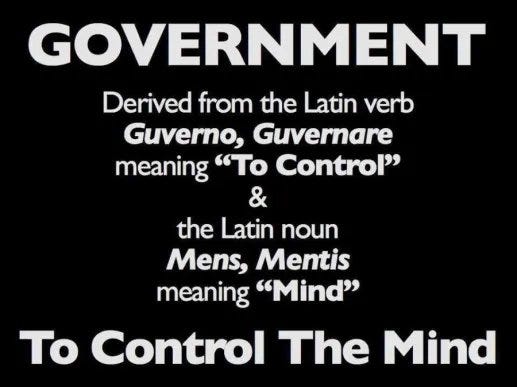
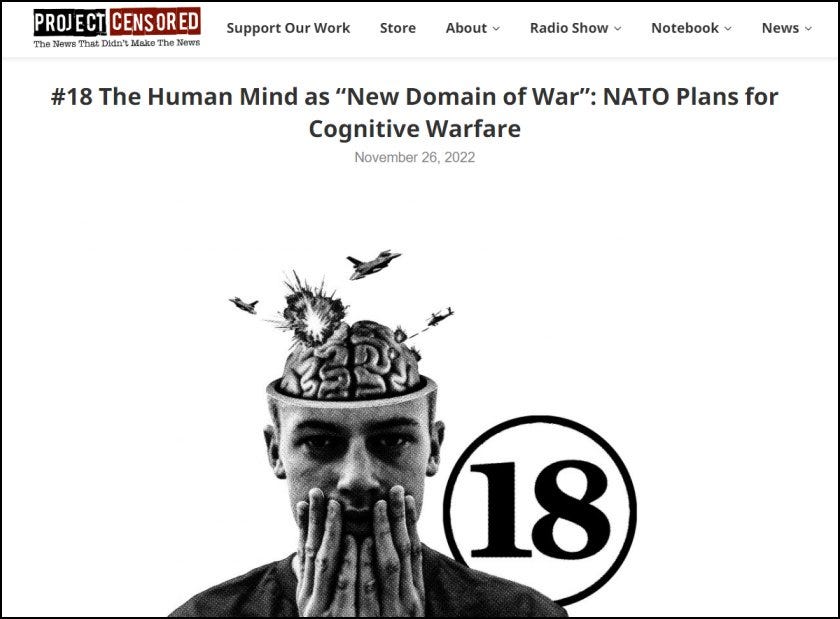

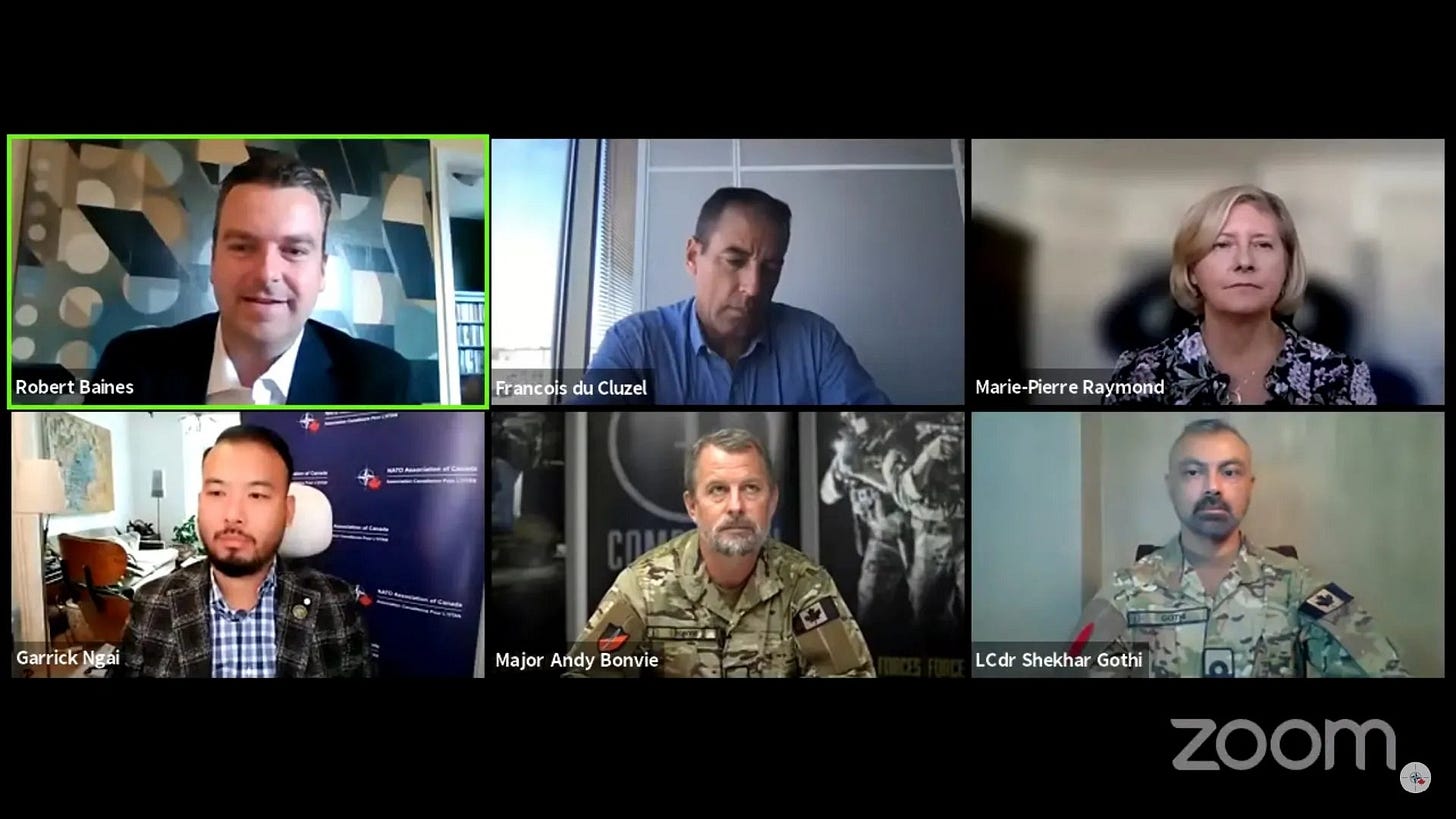

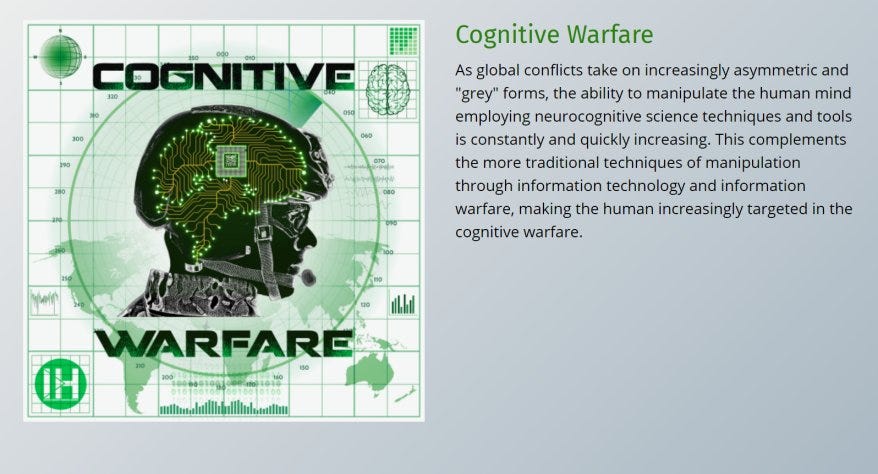
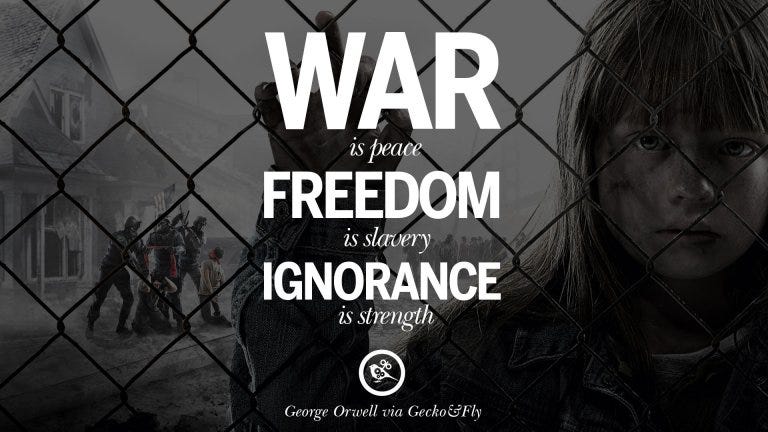

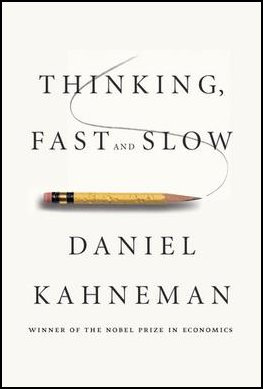
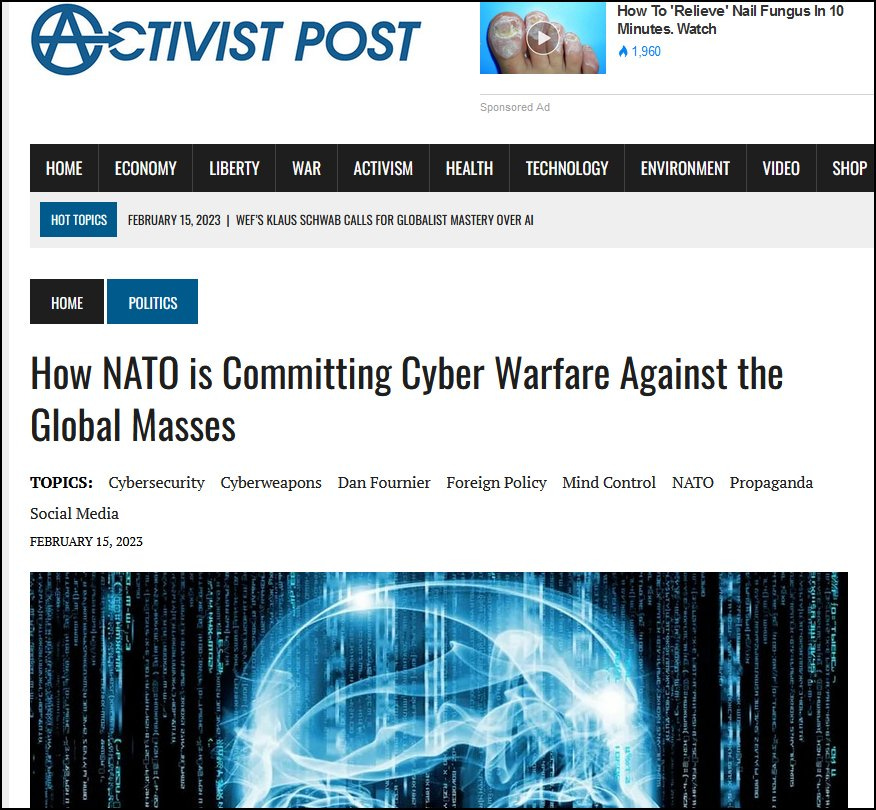
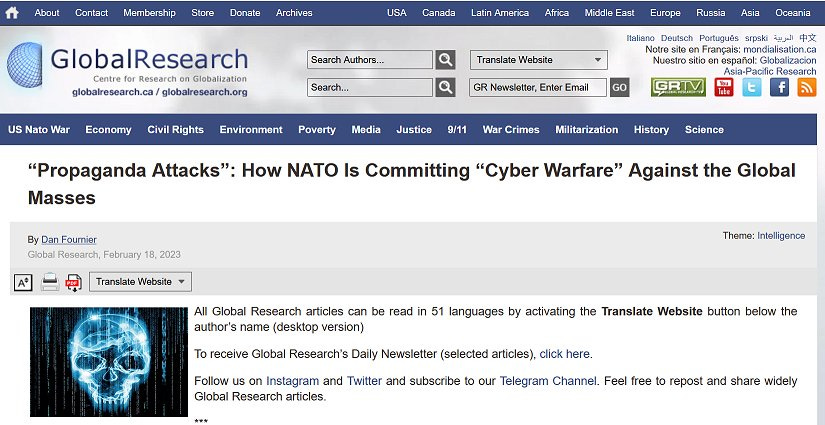



Dan,
This world is full of shapeshifters and spooks. Think Neil Young, Michael Caine or Elton John, as just a few prominent examples. People aren't always what we might think, and neither are their allegiances or paymasters. It is interesting to note, for example, that Daniel Kahneman is an Agenda Contributor at the WEF.
https://www.weforum.org/people/daniel-kahneman
Perhaps we should think nothing of it, because so are such luminaries as Jane Goodall and David Attenborough - and we all know how little influence they both have on public opinion and sentiments.
Kahneman also cut his academic and scholarly teeth at Hebrew University, the same institution that seems to have coughed up Yuval Noah Harari.
From a Harvard Gazette article, Kahneman is quoted as saying:
"How do you convince someone to do something they don’t want to do? Like, for example, get vaccinated, reject prejudices, or accept your terms? “You begin by asking ‘Why not?’ instead of ‘Why?’” Nobel Prize winner Daniel Kahneman said at a Harvard event last week. “It’s the best idea I’ve learned in psychology.”
https://news.harvard.edu/gazette/story/2021/12/daniel-kahneman-on-how-to-influence-others/
(Harvard, as you'll recall, was the birthplace of the illustrious career of Chief Planetary Villain in Residence - one Klaus Schwab.)
One can almost draw a straight line between a statement like that above and some of the chilling assertions Harari has made in recent times such as this:
"Covid is critical because this is what convinces people to accept, to legitimize TOTAL BIOMETRIC SURVEILLANCE. If we want to stop this pandemic, we need not just to monitor people, we need to monitor what's happening under their skin."
(If I could get Harari in a room alone, perhaps over a beer or a jar of human blood or whatever he drinks for fun or sustenance, I would love to ask him: Who is this "we" you keep referring to, Yuval?)
https://sp.rmbl.ws/s8/2/S/T/_/6/ST_6g.caa.mp4?u=3&b=0 (3 minutes)
(Please make sure no children are within earshot of this short video - it may harm them for life!)
Exoposing Globalist Circus for what it is a Circus, is worth every world.